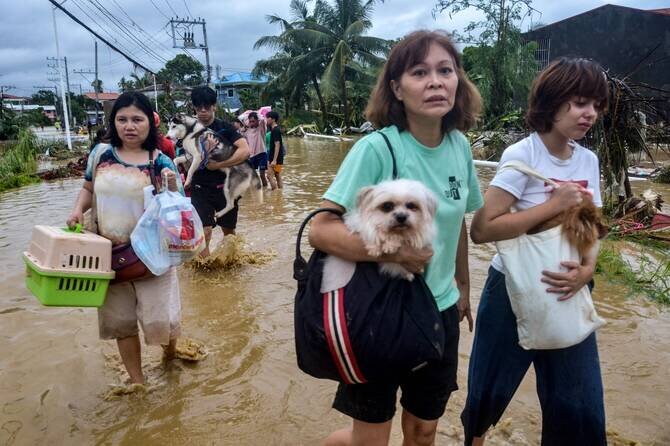
Typhoon Kalmaegi Leaves 66 Dead in Philippines
The central Philippines experiences widespread flooding and destruction as Typhoon Kalmaegi makes landfall, exacerbated by existing flood control issues.
Typhoon Kalmaegi has resulted in at least 66 fatalities and 26 missing individuals across the central Philippines.
The majority of these deaths occurred in Cebu province, which suffered from severe flooding and landslides triggered by the typhoon.
Reports indicate that numerous residents were stranded on their roofs as floodwaters rose, leading to drowning among others.
Additionally, a separate incident involved the crash of a Philippine air force helicopter in Agusan del Sur province, resulting in six further fatalities.
The typhoon's sustained winds reached up to 130 kph (81 mph) and gusts up to 180 kph (112 mph), causing extensive damage across Cebu.
The flooding was worsened by concerns over substandard flood control projects and quarrying activities that contributed to the sedimentation of waterways, thereby exacerbating the impact of the storm.
This has reignited discussions about accountability in infrastructure development.
Prior to making landfall, authorities evacuated more than 387,000 individuals in preparation for the typhoon's anticipated destructive winds and storm surges, potentially reaching up to three meters (10 feet) in height.
The Philippines is known for its vulnerability to natural disasters, with approximately 20 typhoons and storms impacting the country each year.
Meanwhile, central Vietnam is bracing for further rainfall from Typhoon Kalmaegi as it approaches the coast.
Emergency measures are being implemented to manage both the storm's impact and subsequent flooding.
The Philippines' disaster-prone nature, coupled with recent events such as earthquakes and volcanic activity, underscores the ongoing need for comprehensive disaster management strategies.
The majority of these deaths occurred in Cebu province, which suffered from severe flooding and landslides triggered by the typhoon.
Reports indicate that numerous residents were stranded on their roofs as floodwaters rose, leading to drowning among others.
Additionally, a separate incident involved the crash of a Philippine air force helicopter in Agusan del Sur province, resulting in six further fatalities.
The typhoon's sustained winds reached up to 130 kph (81 mph) and gusts up to 180 kph (112 mph), causing extensive damage across Cebu.
The flooding was worsened by concerns over substandard flood control projects and quarrying activities that contributed to the sedimentation of waterways, thereby exacerbating the impact of the storm.
This has reignited discussions about accountability in infrastructure development.
Prior to making landfall, authorities evacuated more than 387,000 individuals in preparation for the typhoon's anticipated destructive winds and storm surges, potentially reaching up to three meters (10 feet) in height.
The Philippines is known for its vulnerability to natural disasters, with approximately 20 typhoons and storms impacting the country each year.
Meanwhile, central Vietnam is bracing for further rainfall from Typhoon Kalmaegi as it approaches the coast.
Emergency measures are being implemented to manage both the storm's impact and subsequent flooding.
The Philippines' disaster-prone nature, coupled with recent events such as earthquakes and volcanic activity, underscores the ongoing need for comprehensive disaster management strategies.










